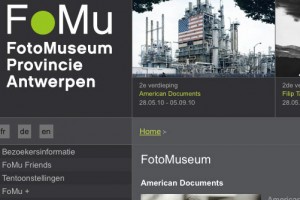
For a while now, I’ve been wanting to write a review of a photographic exhibition. I wasn’t especially concerned by which exhibition, more that I wanted to look at an exhibition holistically: as a collection of photographs that had been brought together with a specific aim or purpose. I wanted to consider what I thought worked, what didn’t, and what could be done better. Ultimately, I wanted to be able to say if I thought that the exhibition had achieved its aim, or if it had made me feel something.
When I was on holiday – exploring Flemish cathedrals and drinking Trappist beer – I spent an afternoon at the Antwerpen FotoMuseum, or FoMu. Amongst its other exhibitions, it was displaying a collection of photographs taken by Belgian photographers in the inter-war years.
The potential for the exhibition was sweeping. Its introduction said how: ‘…the period between the two world wars was a time of sweeping social changes. Developments in photography reflect this,’ as well as mentioning the ‘fierce conflict’ that arose between traditionalist and modernist photographers. I was looking forward to an exhibition of contrasts and of conflicts, a series of photographs that illustrated progress in photography and changes in society. I looked back on an exhibition that disappointed me and didn’t live up to its potential.
What I saw was an interesting selection of photographs – portraits and landscapes, street scenes and still lifes, abstracts and studies – that had been beautifully framed, some of which were unusual and some thought-provoking, but I felt as if there was nothing more to the exhibition than a group of pictures taken between 1918 and 1939. There was no sense of cohesion, no aim, no signal emotion aroused by the images. If there was an objective to the exhibition, I couldn’t tell you what it was, and in my case it certainly didn’t accomplish it.
Organisation
Perhaps the most obvious way to arrange the collection would have been chronologically, which would have charted the devastated landscape, shredded society, and ruptured economy of 1918 that rose, grew, and progressed through the 20s and 30s to women’s suffrage, the jazz age, and technological accomplishment, before collapsing into the abyss of the totalitarian invasion in 1939. But it wasn’t chronological. I wasn’t able to see social change and innovation depicted in a series of photographs.
It’s possible that a curator would prefer to move away from the obvious, perhaps instead exploring the photographs thematically. The vast range of pictures available could have been arranged according to any principle you might imagine, and within those principles it would have been so easy to compare the traditionalists with the modernists and enjoy the artistic conflict of the time. Portraits, landscapes, and still lifes; studies in light and shade, texture, and natural phenomena; contrasts of mundane and usual. Instead, I found myself looking at a pair of beautiful studies of light and shade – chess pieces in shade and a woman’s hand holding a coffee cup – that had been flanked inexplicably by a street scene and an uninspiring still life. A series of three nudes were hung between a picture of a child doing arithmetic and a woman rowing on a lake. Whatever feelings those nudes might have aroused were superbly stifled by the pictures adjacent to them.
Tucked around a corner, as the exhibition reached its close, were two beautiful abstract portraits: a pair of eyes and a hand resting on a book. How effective could it have been to pair these with more traditional portraits? A sort of compare and contrast exercise, if you like. Instead, I very nearly missed them. It was only because I took a second turn around the gallery that I found them. I’m sorry if someone else should have missed these gems.
The art of showing less
FoMu had an opportunity to present something beautiful here; something unusual and enlightening that displayed some searing pictures. Instead, I felt as if the exhibition curator was so overwhelmed by the possibilities to present the pictures that he flung them at the walls and hung them where they stuck. Rather than leave the exhibition feeling as if I’d enjoyed a journey through the Belgian photographic psyche, I felt a sense of discordance. I didn’t know what the angle of the exhibition was and I had no lever into it. All the same, I’m glad that I went, and there’s a picture of some piercing eyes that I’ll not forget in a hurry.
Pictures have a wonderful ability to inspire, be it awe, surprise, amusement, social enlightenment, even historical insight. Let them do that.
Photography in Belgium Between the Wars,
FotoMuseum.be / FotoMuseum, Waalse Kaai 47, 2000 Antwerpen, Belgium





